Your "Not-So-Easy" to Train Pug and What to do About It
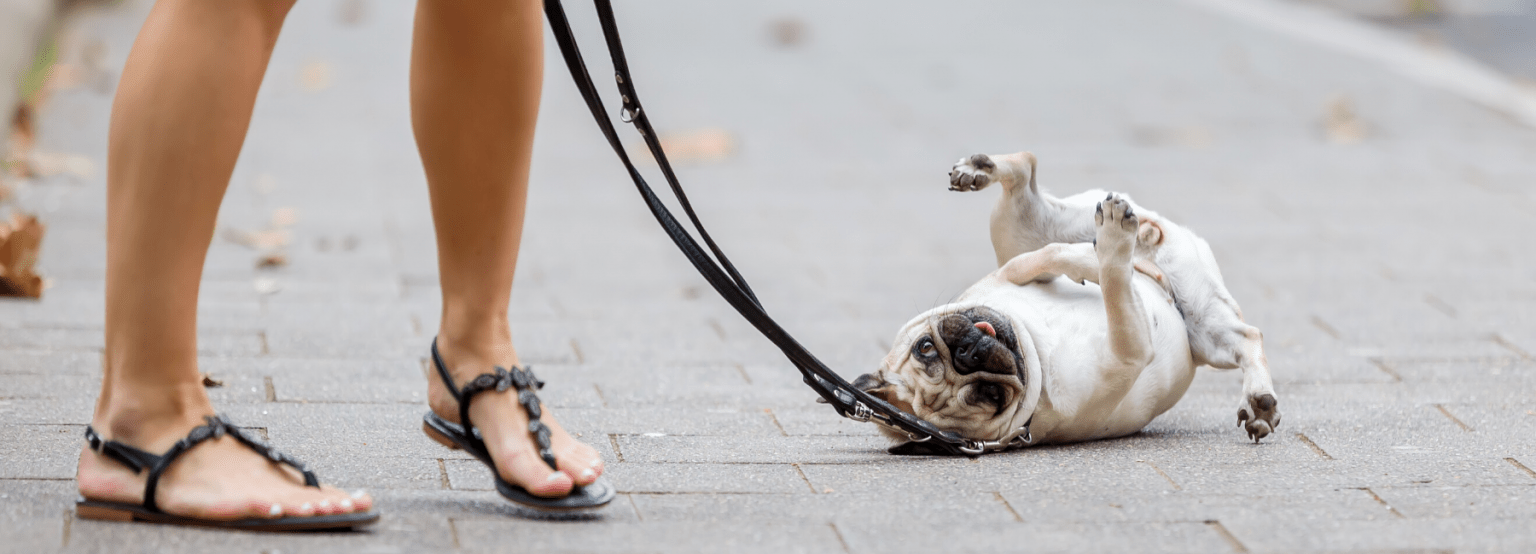
Are Pugs Easy to Train?
I’m just going to say it and not sugar-coat it. Pug training is challenging, demanding, challenging, and sometimes painful! Pugs are easily distractible, can be stubborn, and get easily bored. Overall, Pugs are disinterested in Pug training. It’s the treats that keep them going.
Many Pug parents don’t bother with Pug training. Once they get them to pee outside, which can take some time if, why bother? Pugs have a happy attitude and are excellent companion dogs. They want to cuddle, play, and they’re fun to have around.
If they’re sitting in your seat (again), you pick them up and move them. Pug dogs are not 100 lb. Bernese Mountain Dog. You would not try to pick up a 100 lb. dog, but with our Pugs, we do it all the time.
Pugs have difficulty with limits and boundaries. Actually, they think we are the ones with the problem with too many limits. Anyhow, Pug parents spend a lot of time picking them up or moving them over. How about squishing yourself into the small spot their Pugs have left you on the sofa.
Pug training is not as necessary as it is with larger dogs. If your Pug is barking and going crazy when someone knocks on the door, you pick them up when you open the door.
If your Pug jumps on someone, the other person will usually bend down and pet them. They reward his jumping by giving him positive attention. They’re not a German Shepard who will knock your friend over.
One of the first things people with big dogs is to teach them not to jump. It seems most Pugs jump on people their entire lives.
Everyone loves a Pug!?
So Why Train your Pug?
We train our Pugs, so they don’t pee and poop on your floor. Train, so they don’t chew up your furniture and shoes. Do you want this angel stepping on your gut and other sensitive areas every time you sit down? If you don’t do any Pug training, they walk all over you like you are a piece of furniture.
Pug training helps with your Pug’s mental and physical activity. Pugs love the attention you give them when training. You’ll bond even more. Even though you and your Pug are already codependent, we can never get enough Pug time! And Pug training means more treats for your Pugs!
Check your Own Behavior
We know our Pugs can be quirky and kooky. It is difficult to request anything your Pug wants because of their sweet babyface. Those big, innocent eyes look at us like, “Can’t you do it, Mom?” They light up our lives each moment we are with them. We do anything to keep our Pugs spoiled. So what if I can’t move in bed at night because it will disturb my Pug? At least my Pugs are comfortable!
Pugs are cute ‘straight out of the box.’ They are lovely companions and good-natured. They love to be with you, cuddle and play with you. I usually drink my cup of coffee in the morning with a Pug pressed to each of my sides. All that is so great, but you want to be able to communicate some basic day-to-day behaviors at some point. These basics could be things like going outside when you open the door.
Do you have a Pug that goes to the door, but the moment you open it, they just stand there and look out? Mimi often goes to the door and sits as if she wants out. About 1/3rd of the time, when I walk over to let her out, she leaves when I’m halfway there. Another 1/3rd of the time, she looks out when I open it, decides “forget it,” and goes back to the couch. The last 1/3rd of the time, she actually goes outside.
Do you have a Pug who will stare you down when it’s walk time? Wouldn’t it be nice to go for a walk on your schedule, not your Pugs? Pugs know what they want and can be quite persistent. This is why Pug training is so necessary.
Here’s a Chart of Pug Characteristics and Quirks that May Help or Hinder Your Pug Training
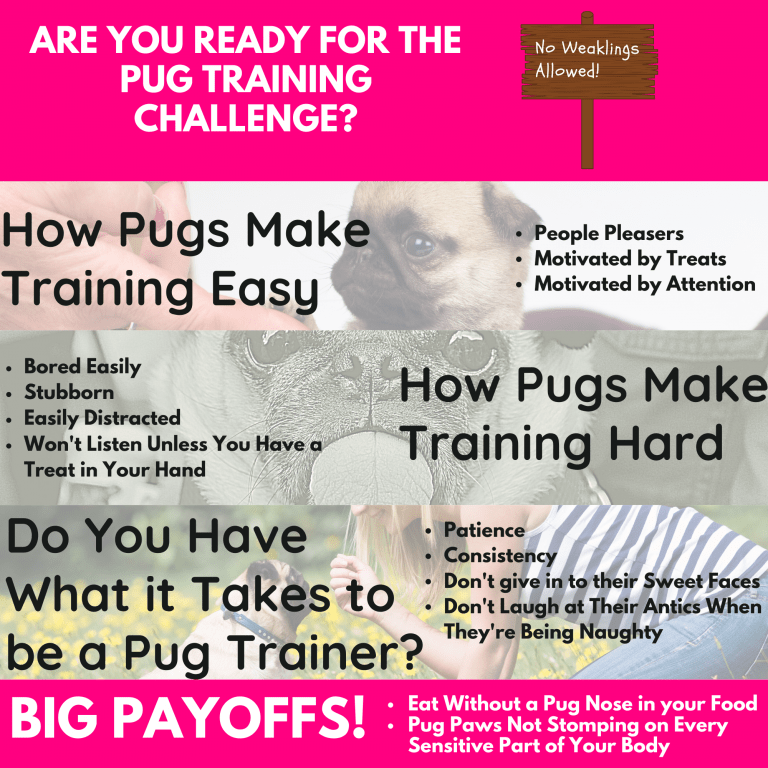
Pug Puppy Training
In general, Pugs do take longer to house train than most breeds. They need to be taken outside during the middle of the night for many months. It’s not impossible. It takes more consistency and vigilance to get your Pug house trained.
Set a Routine
To potty train your Pug puppy, take her outside immediately after each meal and every two hours. Go outside with your Pug, and when she does her business, make a big deal out of it. Along with the praise, give her a small treat.
Give the treat each time she does her business outside. It seems to take Pugs longer than other breeds to figure out that you want her to pee and pooh outside.
When inside, have Your Pug in eyesight at all times. Pug training means not letting them sneak away to their favorite hiding spot to pee.
Some people suggest putting the Pug puppy in a crate at all times you are not interacting with them. Although it would work, I can’t do it. And I don’t think most Pug owners could either.
You may have to keep them in eyesight for their entire first year of life. Yes, I know that’s a long time! Using baby gates are an excellent way to keep your Pug puppy with you in the family room.
Close all bedroom doors. Pugs especially love peeing on the carpet, preferably if it’s brand new!
Take your Pug puppy in the kitchen with you while you are making dinner. That shouldn’t be difficult. Pugs learn that the kitchen is the place a tidbit may fall their way at a very young age. Funny how they can learn this quickly, but the Pug training we want often goes slowly!
And even take your Pug puppy into the bathroom with you. This is all part of Pug training. They may not be fast at learning to pee outside, but they are fast at peeing when you’re out of the room for a minute.
Buy an exercise pen. If you need to go outside and get the mail or can’t watch Pug puppy for a few minutes, simply put her in the exercise pen. Make sure the pen isn’t on the carpet. She is less likely to pee or pooh in this area once she learns it is her area. Also, cleanup is easier if you know exactly where to look.
Crate your Pug Puppy at Night
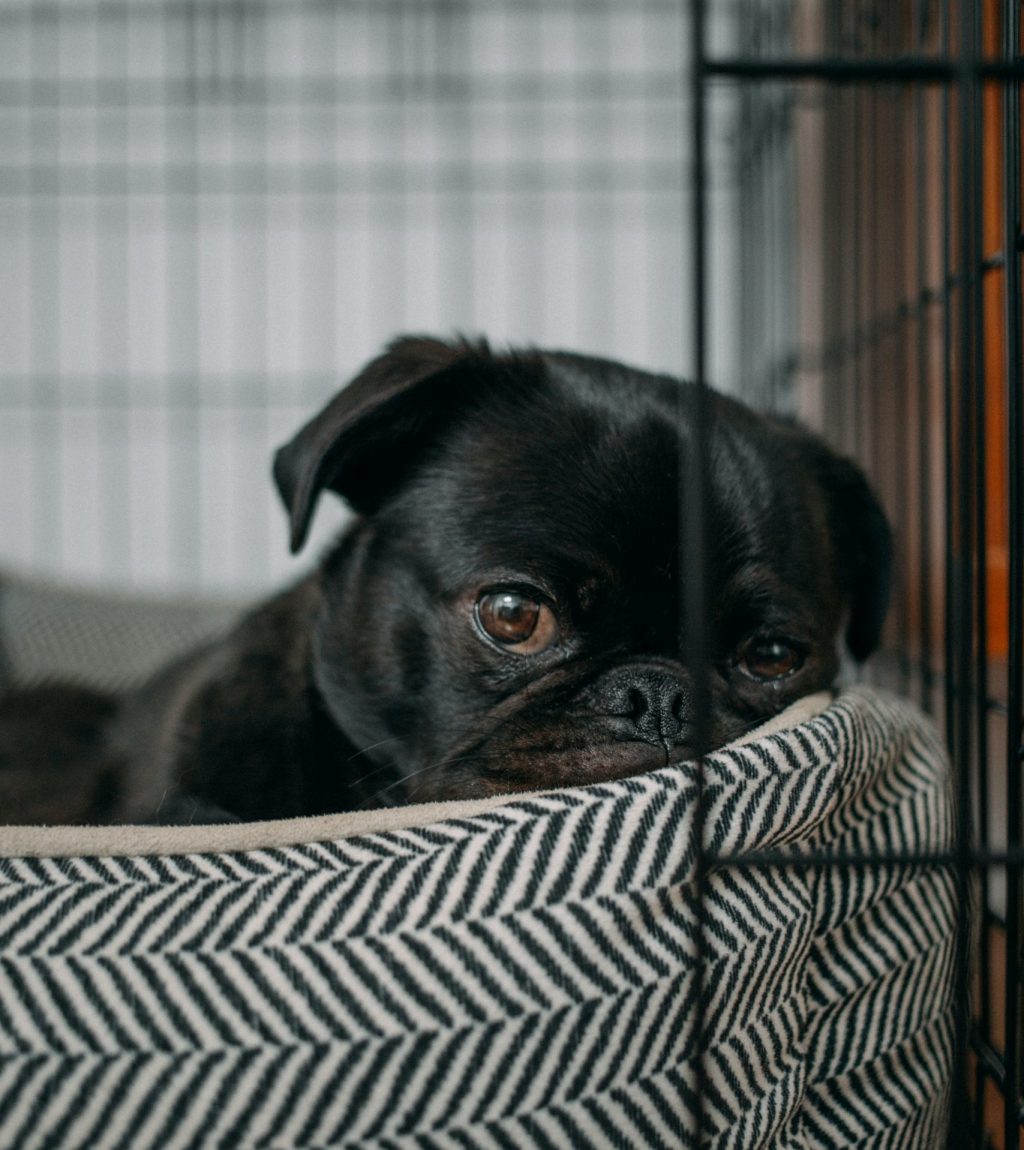
Yes, I know this is difficult. I’ve wasted too much time washing bedding. Other than wasting all that time, you will end up with a have a half-housetrained Pug dog.
Buy a big enough crate that your Pug puppy can stand, turn around, and lay down. Put a comfy blanket in for sleeping. Dogs, in general, will not pee in the area they sleep. If the crate is too big, she may pee in it and move to the other side to sleep.
As your Pug grows, you will have to purchase a larger crate. And don’t ever get rid of your crates once your Pug outgrows them. You may be telling yourself that you’re not getting another Pug puppy, but wait. You may.
I’ve also used a larger crate from the beginning and blocked off half with a box. When my Pug got larger, I took the box out so she would have more room.
Keep the crate in your bedroom, or close enough, you can hear her cry if she has to get up in the middle of the night. Mimi never needed to get up in the middle of the night. Lulu must have had a small bladder and would whimper halfway through the night. She would go every night, so I know she had to go. She wasn’t just lonely in there.
If your Pug puppy cries to get out of her crate when you first put her in, ignore her. Do not tell her to “shush,” talk to her or respond in any way. It is difficult, but any feedback is a reinforcement for her to keep crying.
Half the battle in Pug training is not giving in when they cry, whine or look at you with those big Pug eyes.
Never take her out of the crate to comfort her. Be consistent. She will learn her crate is her new nighttime home (at least until she stops peeing in the bed). She will stop whimpering. Pug training can be so hard for us Pug parents!
Going to Work
Be aware that your Pug puppy cannot hold her bladder all day when you go to work. Their bladders are very tiny when they are puppies.
As part of your Pug training, teach your Pug puppy to use a litter box or puppy pad. When Lulu was a puppy, I left her in an exercise pen when I went to work with a puppy pee pad. I trained her to use the pee pad by placing her on it when I thought she needed to go.
You may come home to a soiled, torn up puppy pee pad. Again, do not put the exercise pen on the carpet. It’s so much easier cleaning up a kitchen floor than cleaning up the carpet in the family room. I purchased a pee pad holder, and Lulu stopped tearing up the pee pads while I was gone.
You can also train your Pug puppy to use a litter box with puppy litter. Litter can be a little messy.
Sometimes it gets kicked out on the floor. Be sure your Pug puppy will not try to eat the litter. That can’t be good for them!
There are indoor dog potties with a grate and pad underneath. Some dog potties have artificial grass. If you want to go all out with Pug training, buy a potty with hydroponically grown grass.
Amazon sells patches of real grass for dogs for about $30. It needs to be changed every week or two and does not have an odor.
Read the reviews. Some people rave about the product. Others gave one-star reviews. People said to go to Home Depot or Lowes and buy a patch of grass for a small fraction of the price.
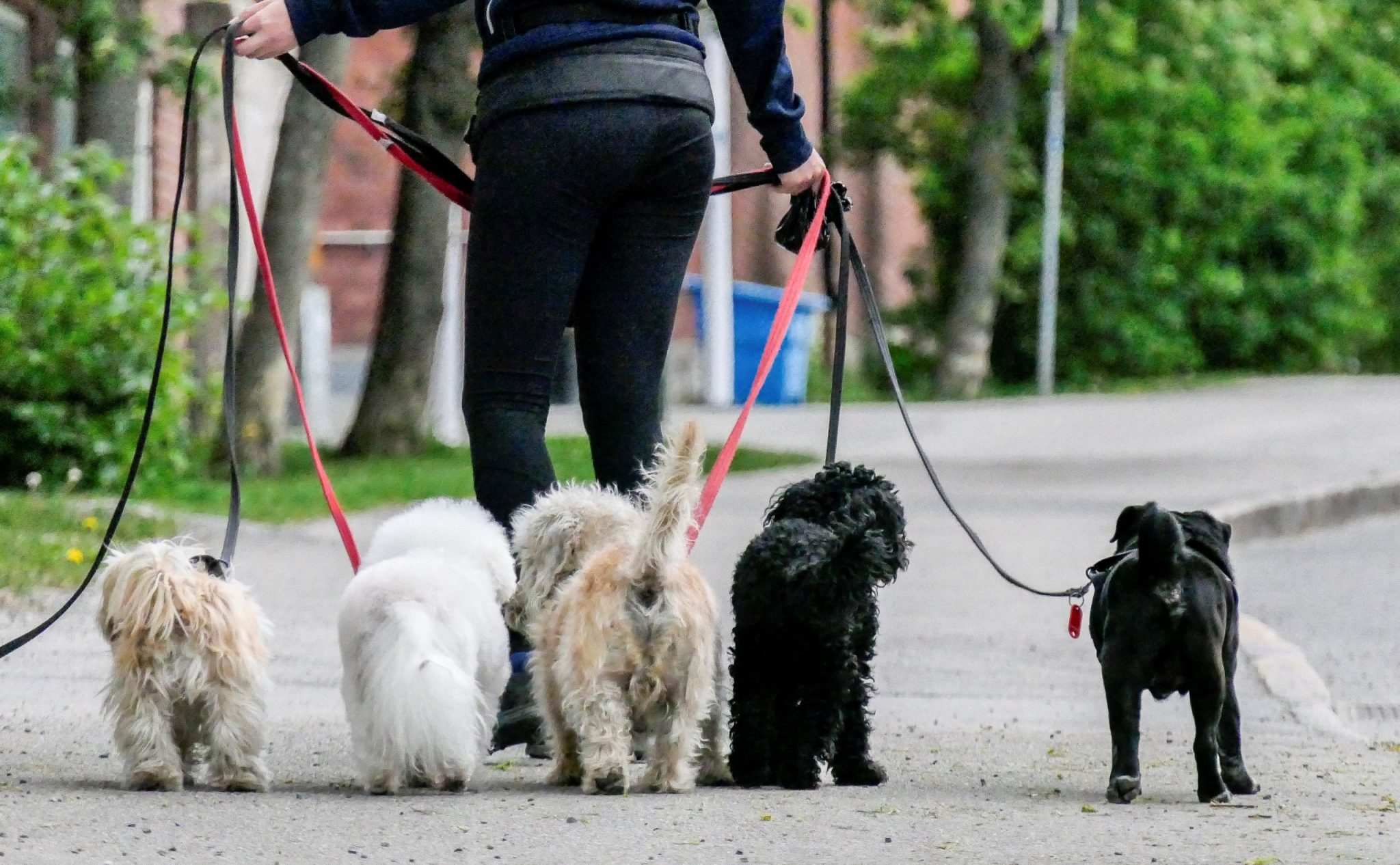
Hire a Dog Walker
Hire a dog walker to take your puppy for a walk once a day while you are gone at work. This may be too expensive. If your Pug puppy is too little to walk on a leash, have them replace the soiled puppy pad and take her out in the yard once a day.
It may be costly, but it won’t be something your Pug needs forever. It’s one of those Pug training expenses that may be costly in the short-term but pays off for the long-term.
Or just change careers and work from home! Even better! Your Pug will love you for it!
Pug Potty Training Success is Up To You
If your Pug training is not successful, don’t blame your Pug. Ask yourself these questions:
- Am I taking your Pug puppy outside after every meal?
- Am I taking your Pug puppy outside every two hours?
- Am I going outside with your puppy, lavishing him with praise and a few treats when he pees and poohs outside?
- Am I keeping your Pug puppy in eyesight 100% of the time when you are home with him?
- Did I purchase an ex-pen in the home to put your Pug puppy if you need to leave the room for a minute?
- Do I have a nighttime crate that is not too large or too small? (And do I use it?)
- Do I ignore your Pug puppy when you put him in initially if he or she cries to get out? This was the toughest one of all when I was Pug training my Pugs.
- When he whimpers in the middle of the night to go out to pee, do I get up?
- Have I hired someone to take your Pug puppy out while I am are at work (if financially feasible)?
- Have you answered all these questions with, “Yes, I do that 100% of the time?”
If not, just keep working on it. Pug training your Pug to potty will go much faster once you can answer yes to all of these questions!
Fix Your Mistakes
Pug training is not easy. Fix your mistakes from the above questions. Work on it until you know you are doing these things 100% of the time.
If, after a few months, your Pug puppy is still having many accidents, talk to your Vet. See if there is a medical reason for this. If not, ask him to refer you to an Associate Certified Applied Animal Behaviorist (ACAAB).
You may pay more upfront to someone with an ACAAB. To become certified with an ACAAB, there are rigorous educational and training requirements. So you’ll increase the likelihood that you can get your Pug dog on the right house training track.
If you hire a dog trainer, they may or may not know more than you already know.
Trainers may or may not have any formal training. Be certain to ask your Vet for a reputable trainer and get referrals. Once I hired a trainer, and he was totally against giving dogs treats. I didn’t know this when I started. I decided not to continue with him. Pugs are food motivated. Why not take advantage of that with our Pug Training?!
Pug Training Your Older Pug
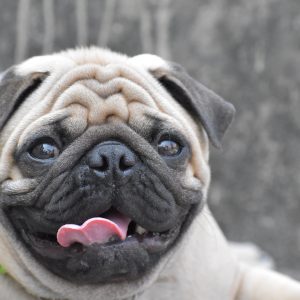
It’s never too late to start Pug training.
|
Sometimes puppyhood slips by quickly. The next thing you know, you’re celebrating his or her 1st birthday. Whether you didn’t train when your Pug was a puppy or adopted an adult Pug dog, it’s never too late to start Pug training.
Be Patient
If you’re training your own Pug dog that you have had since a puppy, he may have acquired some bad habits. After all, there is a reason you decided to train him now.
You may have been rewarding him for years for things like scratching at the door. He scratches at the door, and you get up and let him out. That’s his reward. He’s getting let out. You have already been doing Pug training, but not in a good way.
Now you may want to train him to ring a bell on the door with his nose. This trick is more complicated because he must also learn to stop scratching on the door. If door scratching has worked for him for years, it may be difficult for him to give that up.
Your Pug dog may walk on you all the time! After all, it is about their comfort. Getting them to respect your physical boundaries can be challenging. After all, he’s always known this is “normal.” Pug training includes changing the ways we have already spoiled them.
If you’ve adopted an older dog through a rescue or shelter, he has his own history. Let him adjust to his new surroundings. He could be nervous and needs to adjust.
You can start Pug training after about a week in his home, but be sure to make it super positive. You don’t know what has happened to him in the past. Maybe someone attempted to train him with aversive methods. And it could take up to a month for him to adjust to you and your family.
Your adult Pug dog will probably have a harder time learning new tricks or changing old behavior. He or she can do it. Pugs want to please us. It takes more time and persistence. Your adult or adopted dog will appreciate the time you spend with him during Pug training. After all, they’ll get lots of treats and attention!
Be Aware of Your Pug Dog’s Physical Health
If your dog is quite a bit older, he may have physical limitations. As always, watch for labored breathing as he is a brachycephalic breed and may be overweight. Don’t overdo it with your Pug training.
Some things your Pug dog may not be able to do if they require physical exertion. He may have breathing problems, obesity, have joint pain, arthritis, or heart problems.
Don’t fret. There are plenty of cool tricks your adult Pug dog can learn that are not physically stressful. Before Pug training, you may want to talk to your veterinarian. This is to rule out any health issues your adult Pug dog may have.
A dog training class is a great place to take your Pug dog to socialize with other dogs and people. It allows you to see how he interacts with other dogs and strangers in a safe environment.
Many dog obedience classes use the group to train dogs how to interact with each other.
Conclusion
Pugs are very unique dogs. They may be stubborn and endearing at the same time. When Pugs are doing their pug antics, it may be difficult to intervene because it’s just too funny. When your Pug gets the zoomies with carrying your slipper, who wants to stop that?
Yet, with consistency and patience, you will have a better-behaved Pug dog. Pug training dog tricks is fun for both you and your Pug.
Pug puppies and adult Pug dogs bring with them their own set of challenges. A puppy may not have the focus of an adult, and an adult may have picked up some bad habits over the years.
In any event, use the same Pug training methods for both. Reward your Pug dog when they get things correct. Never use aversive punishment or harm your Pug in any way. Pug training is about building confidence, strengthening your relationship, and having fun.
Training your Pug may be challenging and need a lot of patience and consistency. But as a reward, you will have a well-behaved dog and a better relationship with your Pug. Your Pugs reward will be spending lots of positive, active time with you. And getting treats and lots of praise!
